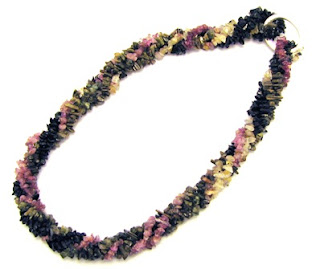 Tourmaline can form in a variety of colors.
Tourmaline can form in a variety of colors.
One of the most interesting properties of tourmaline is that it is pleochroic – this means that it appears different colors when seen from different axes of the crystal. It also has electrical properties, and when heated can become positively and negatively charged, attracting dust particles. In fact, the word tourmaline comes from the Sinhalese word turamali, meaning “stone attracting ash”. Tourmaline can be found as prismatic crystals in a hexagonal shape, from very large to the very small.
Tourmaline can be found as prismatic crystals in a hexagonal shape, from very large to the very small.
Tourmaline is most often associated with igneous rocks, such as granites or pegmatites, however it can be found in some metamorphic rocks. It is commonly found with other minerals such as quartz, beryl, and topaz. Tourmaline can also occur inside quartz as thin, needle-like crystals, forming what is known as tourmalinated quartz. While found all over the world, tourmaline has been found in great quantities in the USA, in particular the states of Maine and California. Most tourmaline used in jewlry comes from the elbaite group.
Most tourmaline used in jewlry comes from the elbaite group.
Tourmaline is the birthstone for October. In metaphysical sense, tourmaline is said to dispel negative energies and enhance the mind. The black variety schorl, is said to have been used in the past to create mourning jewelry. The pink and green varieties are said to have been used as funeral gifts by some Native Americans.
If there's a stone you would like to know more about - drop me a line! Have a mystery stone? Feel free to post a comment about it, including a link to a picture, and it could be featured on this blog!
Tourmaline Facts:
Chemical composition: Varied - in general it is
Na(Mg,Fe,Li,Mn,Al)3 Al6(BO3)3 Si6O18 (OH,F)4
Crystal System: Hexagonal
Color: Varied: pink, green, brown, yellow-green, dark blue, black (most abundant)
Habit: Prismatic crystals or massive
Fracture: Uneven or subconchoidal
Cleavage: Poor, rhombohedtral
Luster: Vitreous
Hardness: 7
Specific Gravity: 3
Streak: Colorless/White
Occurrence: Worldwide
References
A Guide to Rocks and Fossils by B. Busbey III, R. R. Coenraads, P. Willis, and D. Roots. Published 2002 by Fog City Press. ISBN: 1877019518
Rocks, Minerals, & Fossils of the World by C. Pellant and R. Phillips. Published 1990 by Little, Brown and Co. ISBN: 0316697966
Wikipedia – Tourmaline. http://en.wikipedia.org/wiki/Tourmaline
Stone of the Week - Tourmaline
Saturday, January 12, 2008
While many believe that diamonds are the most valuable stones on the planet, there are several that can exceed the value, including tourmaline. Tourmaline is a complex mineral, resulting in its fabulous variety of colors. Tourmaline is divided into seven different groups based on its chemistry: schorl (black) is the most abundant, elbaite (many colors), dravite and buergerite (brown), rubellite (pink), chromdravite (green), and uvite (black, brown, and yello-green). Of all the color varities, the pink and watermelon (green & pink bands) are often the most sought after. Most gem quality tourmaline is in the elbaite group.
Subscribe to:
Post Comments (Atom)

2 comments:
How pretty - and educational!!! I'd love to know more about Chinese Puzzle Stone. Is it white turquoise, howlite, or something all together on its own. :-) GREAT blog!!!
I love this blog. I work a lot with semi-precious stones, and tourmaline is one of my favourites... I especially like black tourmaline because of the depth and richness of its colour.
Thanks so much for educating all of us!!!
Post a Comment